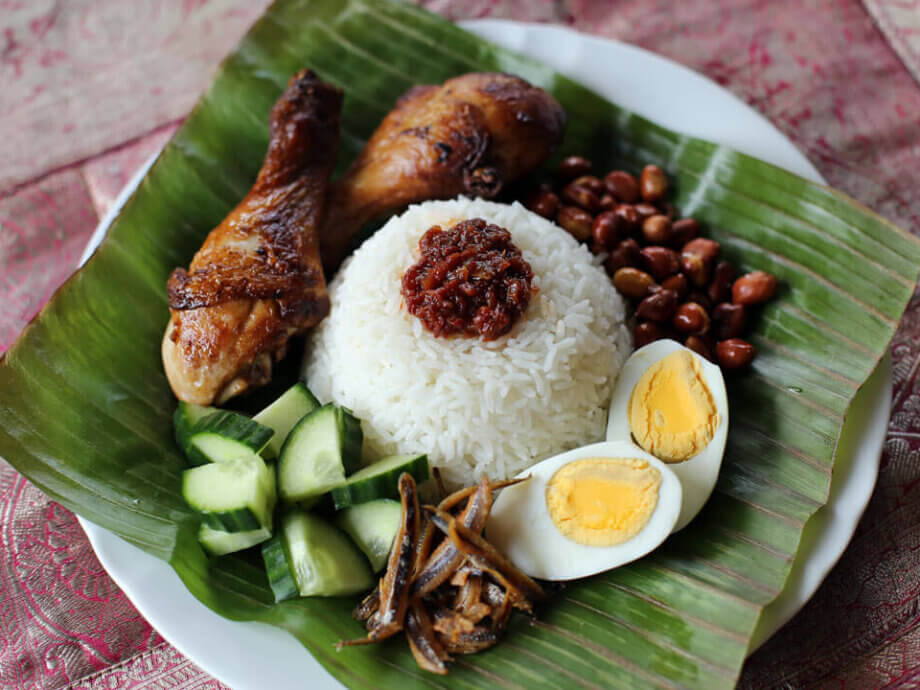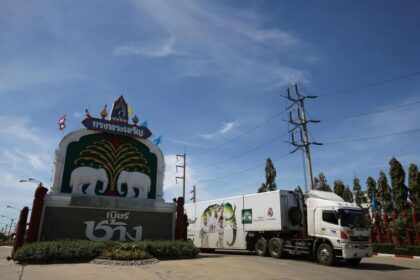The Heart of Malaysia: Nasi Lemak’s Enduring Appeal
Nasi lemak is more than just a meal in Malaysia—it is a symbol of national identity, a source of comfort, and a culinary tradition that unites people across ethnic, social, and generational lines. From humble roadside stalls to high-end restaurants, this fragrant coconut rice dish is a daily ritual for millions and a must-try for visitors. Its story is one of history, adaptation, and deep emotional resonance, making it not only Malaysia’s unofficial national dish but also a candidate for UNESCO’s Intangible Cultural Heritage list.
- The Heart of Malaysia: Nasi Lemak’s Enduring Appeal
- What Is Nasi Lemak?
- Historical Roots: From Farmer’s Fuel to National Staple
- Why Malaysians Love Nasi Lemak: Comfort, Nostalgia, and Unity
- The Essential Components: What Makes a Great Nasi Lemak?
- Regional and Cultural Variations
- Nasi Lemak in Daily Life: Accessibility and Affordability
- From Street Food to Fine Dining: Nasi Lemak’s Culinary Journey
- Nasi Lemak Beyond Malaysia: A Global Comfort Food
- Nasi Lemak’s Role in Malaysian Society and Identity
- UNESCO Recognition and the Future of Nasi Lemak
- How to Enjoy Nasi Lemak Like a Local
- In Summary
What Is Nasi Lemak?
At its core, nasi lemak consists of rice cooked in coconut milk (santan) and pandan leaves, giving it a rich, creamy texture and a distinctive aroma. Traditionally, it is served with spicy sambal (a chili-based condiment), crispy fried anchovies (ikan bilis), roasted peanuts, hard-boiled or fried eggs, and fresh cucumber slices. The dish is often wrapped in banana leaves, which infuse the rice with an earthy fragrance and make it portable—a nod to its origins as a farmer’s breakfast.
But nasi lemak is far from static. Over the years, it has evolved to include a variety of accompaniments such as fried chicken, beef rendang, sambal squid, and even vegetarian or vegan options. Each component plays a crucial role in creating the perfect balance of flavors: the creamy rice, the fiery sambal, the salty crunch of anchovies and peanuts, and the cooling cucumber.
Historical Roots: From Farmer’s Fuel to National Staple
The origins of nasi lemak are deeply rooted in Malaysia’s agricultural past. Early Malay farmers needed a meal that was nutritious, energy-rich, and easy to transport. Coconut milk, abundant in tropical Malaysia, was used to enhance the rice’s flavor and keep it moist throughout the day. Sambal, made from local chilies and anchovies, provided both flavor and protein. Wrapped in banana leaves, nasi lemak became the perfect field meal.
The first written mention of nasi lemak dates back to 1909 in British colonial administrator Richard Olaf Winstedt’s book, The Circumstances of Malay Life. However, the dish’s history likely stretches back much further, with oral traditions and regional adaptations shaping its evolution. Over time, nasi lemak moved from rural villages to urban centers, becoming a staple not just for breakfast but for any meal of the day.
Why Malaysians Love Nasi Lemak: Comfort, Nostalgia, and Unity
For many Malaysians, nasi lemak is a source of nostalgia and comfort. R. Reveka Nair, a company operations executive from Kuala Lumpur, shares:
“It is such a classic Malaysian meal and I have been eating it since I was a child. The aroma of the fresh santan in the rice and the sweet, spicy sambal are what make nasi lemak special. Wrapping it in banana leaves really gives it more oomph.”
Businessman Marcus Quah recalls his school days in the 1990s, when a packet of nasi lemak cost just 60 sen:
“Every day during recess, together with my friends of different races, we would rush to the stall to get a packet before it finishes. Even now when I eat nasi lemak, it brings back fond memories of the good times I had during my school days. We really had a wonderful time then, chatting and playing with friends from different cultures and backgrounds.”
These personal stories are echoed across the country. Nasi lemak is a dish that transcends ethnic boundaries, enjoyed by Malays, Chinese, Indians, and others. Vendor Wasnita Idris, who has run her family’s nasi lemak stall in George Town for 25 years, notes:
“Nasi lemak is something we all can agree on. Whether you are Malay, Chinese or Indian, everyone has their own way of enjoying it.”
The Essential Components: What Makes a Great Nasi Lemak?
While the basic elements of nasi lemak are simple, each component is carefully crafted to achieve a harmonious balance:
- Coconut Rice: The rice is cooked with coconut milk and pandan leaves, sometimes with ginger or lemongrass, resulting in a fluffy, aromatic base.
- Sambal: This spicy, tangy chili paste is the soul of nasi lemak. It is typically made from ground chilies, onions, garlic, shrimp paste (belacan), and tamarind juice. The flavor profile can range from sweet to fiery, depending on regional and personal preferences.
- Anchovies and Peanuts: Fried anchovies add a salty crunch, while roasted peanuts provide a nutty contrast.
- Egg: Usually hard-boiled or fried, the egg adds protein and balances the heat of the sambal.
- Cucumber: Slices of fresh cucumber offer a cooling, refreshing bite.
Vendors and home cooks alike take pride in their sambal recipes, often guarding them as family secrets. Wasnita Idris explains:
“The sambal is the key ingredient, and it could wake any soul. It is made mainly of ground chili, onions, and belacan (shrimp paste), and it takes meticulous preparation. The bilis sambal variant is our trademark.”
Regional and Cultural Variations
Malaysia’s rich cultural diversity is reflected in the many regional and ethnic variations of nasi lemak:
- Malay-Style: The classic version, often wrapped in banana leaves and served with sambal, anchovies, peanuts, egg, and cucumber. In some regions, it is paired with spicy curries or sambal sotong (spicy squid).
- Chinese-Style: Vendors may offer a wide array of side dishes, such as fried chicken, tamarind prawns, soy sauce meat, sausages, and even salted duck eggs. The sambal may be milder or sweeter, reflecting Chinese culinary influences.
- Indian-Style: Indian versions often feature spicier sambal or are served with chicken curry, fish curry, or lamb curry. Some may include chicken masala or varuval, and vegetarian options are also common.
- Modern and Fusion: Contemporary cafes and restaurants have reimagined nasi lemak as burgers, sushi rolls, or even cheesecakes, blending traditional flavors with modern culinary trends.
Each region adds its own twist. In Penang, the sambal is typically sweeter, while Johor’s version is known for its intense shrimp paste flavors. In Sabah, local ingredients like wild ginger or raw fish salad may be included. These adaptations showcase the dish’s versatility and enduring appeal.
Nasi Lemak in Daily Life: Accessibility and Affordability
Nasi lemak’s popularity is due in part to its accessibility and affordability. It is sold everywhere—from roadside stalls and food trucks to mamak (Indian-Muslim) eateries and upscale restaurants. Vendors often start preparing as early as 3 a.m. to meet the morning rush, and packets can be found for as little as RM1, making it an essential meal for students, office workers, and late-night diners alike.
Despite rising costs, some vendors have made headlines for keeping prices low to ensure everyone can enjoy this comfort food. Boy Donny, a seller in Donggongon, Sabah, became a local hero by offering nasi lemak for just RM1, explaining that he wanted to help those struggling financially during tough times. Similarly, Norijan Murat in Simpang Ampat sells affordable nasi lemak to support her family and community.
From Street Food to Fine Dining: Nasi Lemak’s Culinary Journey
While the simplest versions of nasi lemak are found at roadside stalls, the dish has also made its way into high-end restaurants and even the Michelin Guide. Wasnita Idris’s stall in George Town, for example, has been recognized as one of the most affordable entries in the Michelin Guide. Upscale establishments like Village Park Restaurant in Kuala Lumpur are famous for their fried chicken nasi lemak, attracting both locals and tourists.
Modern chefs have embraced nasi lemak’s adaptability, creating gourmet versions with premium ingredients such as lobster sambal or wagyu beef rendang. Fusion creations like nasi lemak burgers and sushi rolls are popular in trendy cafes, appealing to younger generations and international palates.
Nasi Lemak Beyond Malaysia: A Global Comfort Food
Nasi lemak’s appeal has spread far beyond Malaysia’s borders. It is a staple in neighboring Singapore and parts of Indonesia, where similar dishes like nasi uduk and nasi gemuk are enjoyed. The Malaysian diaspora has introduced nasi lemak to countries like Australia, the United States, and Cambodia, where it is served in Malaysian restaurants and celebrated at cultural events.
In Phnom Penh, Malaysian chef Muhamad Faisal Ab Rashid operates “My Kampung” halal cafes, serving nasi lemak and other Malaysian favorites to both locals and expatriates. He notes that the key to authentic flavor is using ingredients imported from Malaysia, especially the distinctive spices and coconut milk.
International recognition has followed. In 2023, Malaysian breakfast culture—including nasi lemak, roti canai, and teh tarik—was showcased at the United Nations headquarters in Geneva, highlighting its role as a cultural ambassador. UNESCO has also nominated Malaysian breakfast culture for inclusion in its Intangible Cultural Heritage list, a testament to the dish’s significance.
Nasi Lemak’s Role in Malaysian Society and Identity
Nasi lemak is more than just a meal; it is a cultural icon that unites Malaysians from all walks of life. It is a common thread in family gatherings, festive celebrations, and everyday routines. The dish’s inclusivity—embraced by Malays, Chinese, Indians, and others—reflects Malaysia’s multicultural society.
Content creators and food bloggers often highlight the emotional connection Malaysians have with nasi lemak. The aroma of coconut rice and sambal evokes memories of childhood, school days, and family breakfasts. As one video by Romana and Fizah revealed, nearly every Malaysian interviewed cited nasi lemak as their favorite dish, underscoring its deep-rooted significance.
Chef Azalina Eusope, born in Penang, describes the experience:
“It’s a sport basically, for all Malaysians. In one bite you get to explore the flavors of Southeast Asia and nearby countries. Each Malaysian state has its own version.”
UNESCO Recognition and the Future of Nasi Lemak
The Malaysian government’s efforts to secure UNESCO recognition for nasi lemak and breakfast culture reflect a broader commitment to preserving and promoting the nation’s culinary heritage. Tourism, Arts, and Culture Minister Datuk Seri Tiong King Sing has emphasized the importance of this nomination, aligning it with Malaysia’s Heritage Year and the country’s reputation as a food destination.
If successful, UNESCO listing would not only honor nasi lemak’s cultural significance but also help protect traditional cooking methods and encourage future generations to cherish and innovate upon this beloved dish.
How to Enjoy Nasi Lemak Like a Local
For those new to Malaysia or visiting for the first time, experiencing nasi lemak is essential. Here are some tips for enjoying it like a local:
- Try Different Versions: Sample nasi lemak from roadside stalls, mamak eateries, and high-end restaurants to appreciate the range of flavors and accompaniments.
- Eat with Your Hands: In traditional settings, nasi lemak is often eaten with the right hand, especially when served on banana leaves.
- Pair with Teh Tarik: Malaysia’s signature pulled tea is the perfect complement to the rich, spicy flavors of nasi lemak.
- Explore Regional Variations: Seek out local specialties in Penang, Johor, Sabah, and other regions to discover unique twists on the classic dish.
In Summary
- Nasi lemak is Malaysia’s beloved national dish, enjoyed by people of all backgrounds and ages.
- Its origins lie in the country’s agricultural past, evolving from a farmer’s breakfast to a symbol of unity and comfort.
- The dish consists of coconut milk rice, sambal, anchovies, peanuts, egg, and cucumber, with countless regional and modern variations.
- Nasi lemak is accessible and affordable, found everywhere from street stalls to Michelin-recognized restaurants.
- It plays a central role in Malaysian culture, evoking nostalgia and bringing people together.
- The dish’s global popularity is growing, with Malaysian communities introducing it abroad and international recognition from UNESCO and the United Nations.
- Efforts to secure UNESCO Intangible Cultural Heritage status highlight nasi lemak’s importance as a living tradition and cultural treasure.












